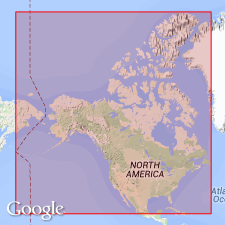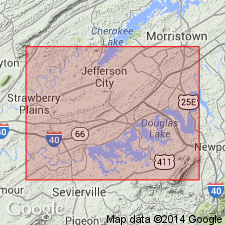
- Usage in publication:
-
- Fetzer tongue
- Modifications:
-
- Named
- Dominant lithology:
-
- Limestone
- AAPG geologic province:
-
- Appalachian basin
Summary:
Named the Fetzer tongue of the Arline formation for Fetzer Creek, near Benton Station, Polk Co., TN. Consists of 6 to 8 feet of nodular crumbly limestone with thin granular interbeds. General lithology is similar to Arline formation and is more argillaceous than the underlying Lenoir limestone. Unit is basically same unit as the Botetourt limestone member of the Edinburg formation of the Shenandoah Valley of VA. Recognized in southeastern belts of the southern Appalachian region from Wytheville, VA to GA. The Fetzer is of Middle Ordovician (Mohawkian) age.
Source: GNU records (USGS DDS-6; Reston GNULEX).

- Usage in publication:
-
- Fetzer Member*
- Modifications:
-
- Revised
- AAPG geologic province:
-
- Appalachian basin
Summary:
Fetzer Member or facies is assigned to the base of the Whitesburg Formation and overlies the Lenoir Formation in this report. Consists of a basal metalliferous carbonate and an overlying limonitic/phosphatic claystone. Unit is a dark brown to dark gray, to nearly black, well indurated, argillaceous carbonate with abundant fossils. Bedding is generally nodular to laminated. The Fetzer proper is at least 5 m thick in the eastern outcrop. On the western end of the outcrop, it is about 2 m thick and overlies a more shaly tongue of the Whitesburg. Authors believe that the Fetzer is not a continuous body of rock but instead consists of lenses.
Source: GNU records (USGS DDS-6; Reston GNULEX).
For more information, please contact Nancy Stamm, Geologic Names Committee Secretary.
Asterisk (*) indicates published by U.S. Geological Survey authors.
"No current usage" (†) implies that a name has been abandoned or has fallen into disuse. Former usage and, if known, replacement name given in parentheses ( ).
Slash (/) indicates name conflicts with nomenclatural guidelines (CSN, 1933; ACSN, 1961, 1970; NACSN, 1983, 2005, 2021). May be explained within brackets ([ ]).

